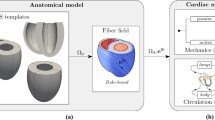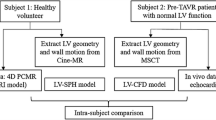Abstract
Cardiac modeling has recently emerged as a promising tool to study pathophysiology mechanisms and to predict treatment outcomes for personalized clinical decision support. Nevertheless, achieving convergence under large deformation and defining a robust meshing for realistic heart geometries remain challenging, especially when maintaining the computational cost reasonable. Smoothed particle hydrodynamics (SPH) appears to be a promising alternative to the finite element method (FEM) since it removes the burden of mesh generation. A point cloud is used where each point (particle) contains all the physical properties that are updated throughout the simulation. SPH was evaluated for solid mechanics applications in the last decade but its capacity to address the challenge of simulating the mechanics of the heart has never been evaluated. In this paper, a total Lagrangian formulation of a corrected SPH was used to solve three solid mechanics problems designed to test important features that a cardiac mechanics solver should have. SPH results, in terms of ventricle displacements and strains, were compared to results obtained with 11 different FEM-based solvers, by using synthetic cardiac data from a benchmark study. In particular, passive dilation and active contraction were simulated in an ellipsoidal left ventricle with the exponential anisotropic constitutive law of Guccione following the direction of fibers. The proposed meshless method is able to reproduce the results of three benchmark problems for cardiac mechanics. Hyperelastic material with fiber orientation and high Poisson ratio allows wall thickening/thinning when large deformation is present.













Similar content being viewed by others
Notes
When the difference in temperature is taken into account, a thermal energy equation should be added in Eq. (2)
References
Allan F (2010) Bower: applied mechanics of solids. CRC Press, Boca Raton
Antoci C, Gallati M, Sibilla S (2007) Numerical simulation of fluid-structure interaction by SPH. Comput Struct 85:879–890
Babuška I, Banerjee U, Osborn JE, Zhang Q (2009) Effect of numerical integration on meshless methods. Comput Methods Appl Mech Eng 198(37–40):2886–2897
Belytschko T, Krongauz Y, Dolbow J, Gerlach C (1998) On the completeness of meshfree particle methods. Int J Numer Methods Eng 43(5):785–819
Biglino G, Capelli C, Bruse J, Bosi GM, Taylor AM, Schievano S (2017) Computational modelling for congenital heart disease: how far are we from clinical translation? Heart 103:98–103
Bonet J, Kulasegaram S, Rodriguez-Paz MX, Profit M (2004) Variational formulation for the smooth particle hydrodynamics (SPH) simulation of fluid and solid problems. Comput Methods Appl Mech Eng 193(12–14):1245–1256
Bonet J, Lok TS (1999) Variational and momentum preservation aspects of smooth particle hydrodynamic formulations. Comput Methods Appl Mech Eng 180(1–2):97–115
Chabiniok R, Wang VY, Hadjicharalambous M, Asner L, Lee J, Sermesant M, Kuhl E, Young AA, Moireau P (2016) Nash: multiphysics and multiscale modelling, data-model fusion and integration of organ physiology in the clinic: ventricular cardiac mechanics. Interface Focus 6(2):20150,083
Chen JK, Beraun JE, Carney TC (1999) A corrective smoothed particle method for boundary value problems in heat conduction. Int J Numer Methods Eng 46(2):231–252
Davies MR, Wang K, Mirams GR, Caruso A, Noble D, Walz A, Lavé T, Schuler F, Singer T, Polonchuk L (2016) Recent developments in using mechanistic cardiac modelling for drug safety evaluation. Drug Discov Today 21(6):924–938
Douillet-Grellier T, Pramanik R, Pan K, Albaiz A, Jones BD, Williams JR (2016) Development of stress boundary conditions in smoothed particle hydrodynamics (SPH) for the modeling of solids deformation. Comput Part Mech 1–21
Duchateau N, Sermesant M, Delingette H, Ayache N (2017) Model-based generation of large databases of cardiac images: synthesis of pathological cine MR sequences from real healthy cases. IEEE Trans Med Imaging 37:755–766
Dyka CT, Ingel RP (1995) An approach for tension instability in smoothed particle hydrodynamics (SPH). Comput Struct 57(4):573–580
Ganzenmueller GC (2015) An hourglass control algorithm for Lagrangian smooth particle hydrodynamics. Comput Methods Appl Mech Eng 286:87–106
Gao H, Wang H, Berry C, Luo X, Griffith BE (2014) Quasi-static image-based immersed boundary-finite element model of left ventricle under diastolic loading. Int J Numer Methods Biomed Eng 30(11):1199–1222
Guccione JM, Costa KD, McCulloch aD (1995) Finite element stress analysis of left ventricular mechanics in the beating dog heart. J Biomech 28(10):1167–1177
Han L, Hu X (2018) Sph modeling of fluid-structure interaction. J Hydrodyn 30:62–69
He L, Seaid M (2016) A Runge–Kutta–Chebyshev SPH algorithm for elastodynamics. Acta Mech 227(7):1813–1835
Horton A, Wittek A, Joldes GR, Miller K (2010) A meshless Total Lagrangian explicit dynamics algorithm for surgical simulation. Int J Numer Method Biomed Eng 26:977–998
Krog ØE, Elster AC (2012) Fast GPU-Based fluid simulations using SPH. In: Lecture Notes in Computer Science (including subseries Lecture Notes in Artificial Intelligence and Lecture Notes in Bioinformatics), vol 7134 LNCS, pp 98–109
Land S et al, Repository for the cardiac mechanics benchmark. http://www.bitbucket.org/sander314/ mechbench. Accessed 20 Jan 2018
Land S et al (2015) Verification of cardiac mechanics software: benchmark problems and solutions for testing active and passive material behaviour. Proc Math Phys Eng Sci 471(2184):20150,641
Lang RM, Badano LP, Mor-Avi V, Afilalo J, Armstrong A, Ernande L, Flachskampf FA, Foster E, Goldstein SA, Kuznetsova T, Lancellotti P, Muraru D, Picard MH, Rietzschel ER, Rudski L, Spencer KT, Tsang W, Voigt JU (2015) Recommendations for cardiac chamber quantification by echocardiography in adults: an update from the American society of echocardiography and the European association of cardiovascular imaging. Eur Heart J Cardiovas Imaging 16:233–271
Leroch S, Varga M, Eder SJ, Vernes A, Rodriguez Ripoll M, Ganzenmüller G (2016) Smooth particle hydrodynamics simulation of damage induced by a spherical indenter scratching a viscoplastic material. Int J Solids Struct 81(December):188–202
Libersky LD, Petschek AG (1991) Smooth particle hydrodynamics with strength of materials. In: Advances in the free-Lagrange method including contributions on adaptive gridding and the smooth particle hydrodynamics method. Springer, Berlin , pp 248–257
Lin J, Naceur H, Coutellier D, Laksimi A (2014) Efficient meshless SPH method for the numerical modeling of thick shell structures undergoing large deformations. Int J Nonlinear Mech 65:1–13
Lluch È, Doste R, Giffard-Roisin S, This A, Sermesant M, Camara O, De Craene M, Morales HG (2017) Smoothed particle hydrodynamics for electrophysiological modeling: an alternative to finite element methods. In: Lecture Notes in Computer Science (including subseries Lecture Notes in Artificial Intelligence and Lecture Notes in Bioinformatics), vol 10263 LNCS, pp 333–343
Mabssout M, Herreros MI (2013) Runge–Kutta vs Taylor-SPH: Two time integration schemes for SPH with application to soil dynamics. Appl Math Model 37(5):3541–3563
Mao W, Caballero A, McKay R, Primiano C, Sun W (2017) Fully-coupled fluid-structure interaction simulation of the aortic and mitral valves in a realistic 3D left ventricle model. PLoS ONE 12(9)
Mao W, Li K, Sun W (2016) Fluid-structure interaction study of transcatheter aortic valve dynamics using smoothed particle hydrodynamics. Cardiovasc Eng Technol 7(4):374–388
Marchesseau S, Sermesant M, Billet F, Delingette H, Ayache N (2015) Personalization of electromechanical models of the cardiac ventricular function by heterogeneous clinical data assimilation. Multi-modality Card Imaging Process Anal
Monaghan JJ (2000) SPH without a tensile instability. J Comput Phys 159(2):290–311
Monaghan JJ (2005) Smoothed particle hydrodynamics. Reports. Prog Phys 68(8):1703
Naceur H, Lin J, Coutellier D, Laksimi A (2015) Efficient smoothed particle hydrodynamics method for the analysis of planar structures undergoing geometric nonlinearities. J Mech Sci Technol 29(5):2147–2155
Ogden R (2011) Nonlinear mechanics of soft solids including biological tissues. The 5th winter school on Appl. Math. Univ. Hong Kong
Rabczuk T, Belytschko T, Xiao SP (2004) Stable particle methods based on Lagrangian kernels. Comput Methods Appl Mech Eng 193(12–14):1035–1063
Rausch MK, Karniadakis GE, Humphrey JD (2017) Modeling soft tissue damage and failure using a combined particle/continuum approach. Biomech Model Mechanobiol 16(1):249–261
Sugiura S, Washio T, Hatano A, Okada J, Watanabe H, Hisada T (2012) Multi-scale simulations of cardiac electrophysiology and mechanics using the University of Tokyo heart simulator. Prog Biophys Mol Biol 110:380–389
Swegle JW, Hicks DL, Attaway SW (1995) Smoothed particle hydrodynamics stability analysis. J Comput Phys 116(1):123–134
Wong KC, Wang L, Zhang H, Liu H, Shi P (2010) Meshfree implementation of individualized active cardiac dynamics. Comput Med Imaging Graph 34(1):91–103
Zhang LW, Ademiloye AS, Liew KM (2018) Meshfree and Particle Methods in Biomechanics: prospects and challenges. Arch Comput Methods Eng 2
Acknowledgements
The work is supported by the European Union Horizon 2020 research and innovation programme under grant agreement No 642676 (CardioFunXion).
Author information
Authors and Affiliations
Corresponding author
Additional information
Publisher's Note
Springer Nature remains neutral with regard to jurisdictional claims in published maps and institutional affiliations.
Rights and permissions
About this article
Cite this article
Lluch, È., De Craene, M., Bijnens, B. et al. Breaking the state of the heart: meshless model for cardiac mechanics. Biomech Model Mechanobiol 18, 1549–1561 (2019). https://doi.org/10.1007/s10237-019-01175-9
Received:
Accepted:
Published:
Issue Date:
DOI: https://doi.org/10.1007/s10237-019-01175-9




